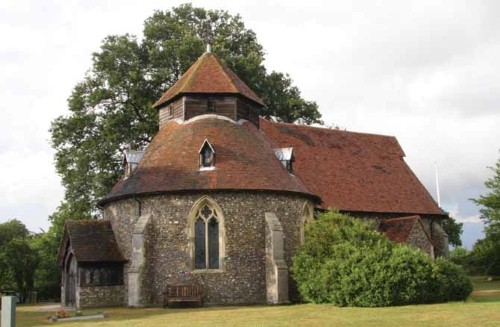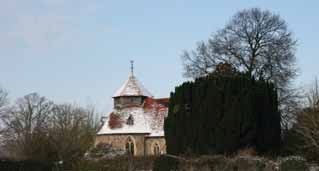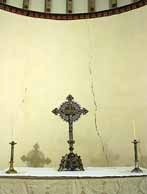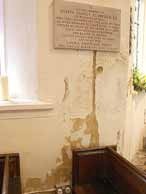THE ROUND CHURCH AT MAPLESTEAD

The Round Church at Little Maplestead.
One of the gems of northern Essex is to be found along a small country lane in Little Maplestead, a few miles northwest of Halstead. Locally known as The Round Church, it sits nestled in a beautiful spot among several ancient yew trees on the crest of a small hill. Approaching by foot across the fields or by road from Halstead it can be seen from quite far off and merits a visit, as it is a very pretty little church and one of the most historically important buildings in the area
Officially known as The Church of St. John the Baptist, the Round Church is one of only four round churches still in use in England. Its history dates back to the Middle Ages although the early records are unreliable. It is generally believed that there was a church near to the site of the current church in late Saxon times, as a priest is mentioned in the Domesday Book, but there is no documentary or archaeological evidence to support this.

The Round Church surrounded by ancient yew trees.
During the Crusades, the manor and church of Little Maplestead were given to the Order of the Knights of St John of Jerusalem, also known as the Knights Hospitaller. After the grant of the land in 1185 by Juliana Fitz-Audelin, the Hospital was founded by the Knights who then built a church for their own use in around 1186, although history does not relate whether or not that church was circular. At around the same time, domestic buildings would have been erected in the surrounding area for the use of the Knights Hospitaller community, including a chapter-house, refectory and dormitories. The preceptory was close by on the site of what is now Maplestead Hall, which can be seen on the other side of the road from the present church. Unfortunately, no evidence of any of these buildings remains, but the Round Church on the site is still associated with the Order of the Knights of St John of Jerusalem today. Every year members of the Order can be seen in procession, clad in traditional full robes, on the first Sunday in June as they celebrate their annual “Service of Thanksgiving and Re-dedication” at the Round Church.
The Order was originally founded in 1092 in Jerusalem with the building of a hospice to accommodate pilgrims visiting holy places. It was first introduced in England in around 1144 to give medical care to sick and injured crusading knights. It eventually became today’s St John Ambulance service which is the UK’s leading first aid provider and training organisation. The Houses of the Knights Hospitaller were dissolved by Henry VIII in 1540, as part of the Dissolution of the Monasteries and most of the knights retired to Malta, becoming known as the Knights of Malta. The Maltese cross of the Knights Hospitaller still forms part of the service’s livery and also features on the traditional robes of the Order. Round churches were built by both the Knights Hospitaller and the Knights Templar. The round design was based on the fourth century rotunda of the Church of the Holy Sepulchre at Jerusalem, which was built by the Emperor Constantine. Constantine’s church was built on what is regarded as the site of Jesus’s tomb and the round shape of the church is thought to celebrate the resurrection. The other round churches still in use are the Temple Church in London, belonging to the Knights Templar, and the Churches of the Holy Sepulchre in Cambridge and in Northampton, but neither of these are connected to the Knights Templar or Hospitaller.
The present church was probably built around 1335 on the site of the church of the Knights Hospitaller and is the latest of the four round churches still in use in England. It is therefore of great importance historically. There is debate about why the circular plan of the church would have been adopted as late as the 14th century, as this style had gone “out of fashion” by the end of the 12th century. One theory is that the circular aisle and walls of the chancel probably date from the late 12th century and the hexagonal arcade within the round dates from a later period. However, there is no sign of work earlier than the 14th century so it may be that the circular form was simply influenced by an earlier round church on the site. The church was dramatically restored between 18511857 when most of the old details were renewed or replaced. It is possible to read what was done in the old minute book of the Restoration Committee which is still in existence. The external walls were completely refaced and the windows and buttresses were renewed. A new roof was added to the chancel and circular aisle, the wooden belfry was rebuilt and the old western porch was replaced with a smaller one. The interior stonework was scraped and much new stone added.
The present font was discovered during the restoration work. It is the most ancient feature in the church and probably dates from 1080. The bowl was originally square but the corners were later cut off, in all likelihood during the 16th century. The font was probably intended for total immersion baptism as was the custom in early Norman times. The western face of the font bears a carving of St Andrew’s cross. As St Andrew was possibly the first bishop of Byzantium, this may account for the presence of his symbol. Apart from the font there are no other treasures of any great significance inside the church, but it is worth a visit for its unique shape and historical importance if you happen to be in the local area. The church today probably looks very much the way it did after the Victorian restoration over 150 years ago. It is made of flint with a tiled roof and a low, six-sided wooden belfry and, as you will see if you visit, it has a very unusual design. It has a six-sided nave surrounded by a circular aisle which forms the round part of the church. Running east from the nave there is an aisle-less chancel terminating in a semi-circular eastern apse which is apparently the only 14th century example of this type which now exists in England. There is a porch on the western end of the nave over an original 14th century doorway which opens into the round. The roof over the nave and circular aisle is of a conical shape and is surmounted by the sexagonal belfry. On top of the belfry sits an iron weather vane with a gilded finial, which is a copy of a similar one which existed in 1836.
Although the Round Church has been rebuilt and restored many times in its long history it is in need of significant restoration once again. At some time in the middle of the twentieth century, the brick and flint exterior was repointed using cement rather than lime mortar, which has proved to be rather disastrous for the church. The fabric of the church cannot breathe and so the interior of the church has become very damp. This is causing the plasterwork inside to crumble and fall off and is now in urgent need of repair. The Friends of the Round Church was set up in 2009 as a charity to raise funds to carry out the remedial works required. So far, the gutters have been replaced and French drains have been installed to keep water away from the exterior walls. Fundraising continues so that the internal plaster can be replaced and, eventually, the cement pointing replaced with lime mortar. Because the church is so tiny, it has a very small congregation and most of the money required will have to come from outside Little Maplestead, either from grants or donors interested in protecting this local treasure.


Damp and cracks causing the plaster to fall off which is in need of urgent repair.
Despite the dilapidations the church is still active locally. Services are held on the first Sunday of every month and several weddings take place every year as it is such a charming location in which to get married. If you would like more information on the Round Church or the Friends of the Round Church, or you would like to make a donation to help with its restoration, please visit the website www.roundchurch.co.uk.
Jane Hartley-Allen
Chairman of the Friends of the Round Church
Jane has lived in Halstead for 15 years. She set up and runs the Friends charity and is involved with fundraising campaigns for the repair of the Church. She is also the Halstead representative for the CSCA.
